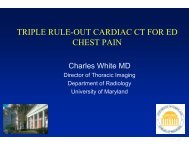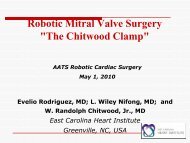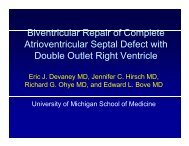Twenty-five years of Research on Cytochromes P450 2B: To ...
Twenty-five years of Research on Cytochromes P450 2B: To ...
Twenty-five years of Research on Cytochromes P450 2B: To ...
- No tags were found...
Create successful ePaper yourself
Turn your PDF publications into a flip-book with our unique Google optimized e-Paper software.
Goals <str<strong>on</strong>g>of</str<strong>on</strong>g> Predictive DrugMetabolism• Overcome metabolic lability <str<strong>on</strong>g>of</str<strong>on</strong>g> a newchemical entity (NCE)• Avoid drug interacti<strong>on</strong>s caused by anNCE• Predict functi<strong>on</strong>al c<strong>on</strong>sequences <str<strong>on</strong>g>of</str<strong>on</strong>g>SNP's (individuals, populati<strong>on</strong>s)• Predict pharmacokinetics <str<strong>on</strong>g>of</str<strong>on</strong>g> an NCE
Overview1. Species, strain, and individualdifferences in <strong>P450</strong> <strong>2B</strong> functi<strong>on</strong>2. C<strong>on</strong>formati<strong>on</strong>al plasticity <str<strong>on</strong>g>of</str<strong>on</strong>g> cytochromes<strong>P450</strong> <strong>2B</strong>3. Multiplicity <str<strong>on</strong>g>of</str<strong>on</strong>g> cytochromes <strong>P450</strong> 3A invarious species4. Cooperativity <str<strong>on</strong>g>of</str<strong>on</strong>g> human <strong>P450</strong> 3A45. Less<strong>on</strong>s learned
Species, Strain, and IndividualDifferences in <strong>P450</strong> <strong>2B</strong> Functi<strong>on</strong>• Mechanism-based inactivati<strong>on</strong>• Steroid hydroxylati<strong>on</strong>• PCB oxidati<strong>on</strong>
<strong>P450</strong> <strong>2B</strong> Enzymes1. Highly inducible by phenobarbital in a number<str<strong>on</strong>g>of</str<strong>on</strong>g> species (human, rat, rabbit, mouse, dog)2. Am<strong>on</strong>g the first <strong>P450</strong>s purified andcharacterized (LM2, PB-B/<strong>P450</strong>b)3. Metabolize angular, medium-sized neutral orbasic compounds4. Exhibit marked species and strain differencesin functi<strong>on</strong>
14 C (cpm)Halpert, J. (1981). Covalent modificati<strong>on</strong> <str<strong>on</strong>g>of</str<strong>on</strong>g> lysine during the suicide inactivati<strong>on</strong><str<strong>on</strong>g>of</str<strong>on</strong>g> rat liver cytochrome P-450 by chloramphenicol. Biochem. Pharmacol.30:875-881.Halpert, J., Miller, N., and Gorsky, L. (1985). On the mechanism <str<strong>on</strong>g>of</str<strong>on</strong>g> theinactivati<strong>on</strong> <str<strong>on</strong>g>of</str<strong>on</strong>g> the major phenobarbital-inducible isozyme <str<strong>on</strong>g>of</str<strong>on</strong>g> rat livercytochrome P-450 by chloramphenicol. J. Biol. Chem. 260:8397-8403.TIME (min)• Chloramphenicol is c<strong>on</strong>verted by <strong>P450</strong> <strong>2B</strong>1 to an oxamyl chloride, whichbinds to the ε-amino group <str<strong>on</strong>g>of</str<strong>on</strong>g> <strong>on</strong>e or more lysine residues in the enzyme.• The modified enzyme is unable to undergo enzymatic reducti<strong>on</strong> by NADPHcytochrome<strong>P450</strong> reductase.
Halpert, J., Balfour, C., Miller, N.E., Morgan, E.T., Dunbar, D., and Kaminsky,L.S. (1985) Isozyme-selectivity <str<strong>on</strong>g>of</str<strong>on</strong>g> the inhibiti<strong>on</strong> <str<strong>on</strong>g>of</str<strong>on</strong>g> rat liver cytochromes P-450by chloramphenicol in vivo. Mol. Pharmacol. 28:290-296.• Chloramphenicol inactivates three (<strong>2B</strong>1, 2C6, 2C11) <str<strong>on</strong>g>of</str<strong>on</strong>g> eightmajor rat liver microsomal cytochrome <strong>P450</strong> enzymes.
Halpert, J., Jaw, J.-Y., Balfour, C., and Kaminsky, L.S. (1990). Selectiveinactivati<strong>on</strong> by chlor<str<strong>on</strong>g>of</str<strong>on</strong>g>luoroacetamides <str<strong>on</strong>g>of</str<strong>on</strong>g> the major phenobarbital-inducibleform(s) <str<strong>on</strong>g>of</str<strong>on</strong>g> rat liver cytochrome P-450. Drug Metab. Dispos. 18:168-174.• N-(2-p-nitrophenethyl)chlor<str<strong>on</strong>g>of</str<strong>on</strong>g>luoroacetamide is aselective inactivator <str<strong>on</strong>g>of</str<strong>on</strong>g> <strong>P450</strong> <strong>2B</strong>1 in vitro and in vivo.
% 16 -Hydroxylase ActivityKedzie, K.M., Balfour, C.A., Escobar, G.Y., Grimm, S.W., He, Y.-A., Pepperl, D.,Regan, J., Stevens, J.C., and Halpert, J.R. (1991). Molecular basis for afuncti<strong>on</strong>ally unique cytochrome <strong>P450</strong>IIB1 variant. J. Biol. Chem. 266:22515-22521.WMIIB11616• A Gly-478 to Ala substituti<strong>on</strong> in <strong>P450</strong> <strong>2B</strong>1 from Wistar-Munich ratsis resp<strong>on</strong>sible for the low androgen 16 β-hydroxylase activity andlack <str<strong>on</strong>g>of</str<strong>on</strong>g> susceptibility to inactivati<strong>on</strong> by N-(2-p-nitrophenethyl)-chlor<str<strong>on</strong>g>of</str<strong>on</strong>g>luoroacetamide.
245-HCB Metabolism(% <str<strong>on</strong>g>of</str<strong>on</strong>g> C<strong>on</strong>trol)Duignan, D.B., Sipes, I.G., Le<strong>on</strong>ard, T.B., and Halpert, J. (1987). Purificati<strong>on</strong>and characterizati<strong>on</strong> <str<strong>on</strong>g>of</str<strong>on</strong>g> the dog hepatic cytochrome P-450 isozymeresp<strong>on</strong>sible for the metabolism <str<strong>on</strong>g>of</str<strong>on</strong>g> 2,2', 4,4', 5,5'-hexachlorobiphenyl. Arch.Biochem. Biophys. 255:290-303.• Canine cytochrome <strong>P450</strong> <strong>2B</strong>11 is resp<strong>on</strong>sible for the hydroxylati<strong>on</strong> <str<strong>on</strong>g>of</str<strong>on</strong>g>245-HCB in liver microsomes from c<strong>on</strong>trol and phenobarbital-treatedanimals.• The high c<strong>on</strong>stitutive expressi<strong>on</strong> and activity <str<strong>on</strong>g>of</str<strong>on</strong>g> this enzyme account forthe unique ability <str<strong>on</strong>g>of</str<strong>on</strong>g> dogs to eliminate 245-HCB in vivo.
Spatzenegger, M., Wang, Q., He, Y.Q., Wester, M.R., Johns<strong>on</strong>, E.F. and Halpert,J.R. (2001). Amino acid residues critical for differential inhibiti<strong>on</strong> <str<strong>on</strong>g>of</str<strong>on</strong>g> CYP<strong>2B</strong>4,CYP<strong>2B</strong>5 and CYP<strong>2B</strong>1 by phenylimidazoles. Mol. Pharmacol. 59:475-484.Inhibiti<strong>on</strong> <str<strong>on</strong>g>of</str<strong>on</strong>g> CYP<strong>2B</strong>4, <strong>2B</strong>5 and <strong>2B</strong>1 byphenylimidazole derivativesCompoundsIC 50CYP<strong>2B</strong>4 CYP<strong>2B</strong>5 CYP<strong>2B</strong>11-Phenylimidazole 0.90 4.2 0.591-(4-Chlorophenyl)imidazole 0.12 15.6 0.08µM4-Phenylimidazole 0.49 8.4 0.264-(4-Chlorophenyl)imidazole 0.04 3.8 0.07• Selective inhibiti<strong>on</strong> <str<strong>on</strong>g>of</str<strong>on</strong>g> <strong>P450</strong> <strong>2B</strong>4 vs. <strong>2B</strong>5 can be rati<strong>on</strong>alized withthe help <str<strong>on</strong>g>of</str<strong>on</strong>g> homology models based <strong>on</strong> <strong>P450</strong> 2C5.• Differences in the determinants <str<strong>on</strong>g>of</str<strong>on</strong>g> inhibiti<strong>on</strong> are caused byresidue-residue interacti<strong>on</strong>s as well as residue-inhibitor c<strong>on</strong>tacts.
% <strong>P450</strong> ExtractedScott, E.E., Spatzenegger, M., and Halpert, J.R. (2001). A truncati<strong>on</strong> <str<strong>on</strong>g>of</str<strong>on</strong>g><strong>2B</strong> subfamily cytochromes <strong>P450</strong> yields increased expressi<strong>on</strong> levels,increased solubility, and decreased aggregati<strong>on</strong> while retaining functi<strong>on</strong>.Arch. Biochem. Biophys. 395:57-68.<strong>2B</strong>1dH <strong>2B</strong>4dH <strong>2B</strong>6dH <strong>2B</strong>11dH<strong>2B</strong> <strong>P450</strong>• <strong>P450</strong> <strong>2B</strong>4 is an excellent candidate for crystallizati<strong>on</strong> trials.
C<strong>on</strong>formati<strong>on</strong>al Plasticity <str<strong>on</strong>g>of</str<strong>on</strong>g> <strong>P450</strong><strong>2B</strong> Enzymes• X-ray crystallography <str<strong>on</strong>g>of</str<strong>on</strong>g> rabbit <strong>P450</strong> <strong>2B</strong>4• Hydrogen-deuterium mass exchangestudies <str<strong>on</strong>g>of</str<strong>on</strong>g> <strong>2B</strong>4• X-ray crystallography <str<strong>on</strong>g>of</str<strong>on</strong>g> human <strong>P450</strong> <strong>2B</strong>6
• protein engineering:highly c<strong>on</strong>centrated proteinsoluti<strong>on</strong>(+ salt, detergent, DTT,EDTA, buffer . . .)+C<strong>on</strong>trol <str<strong>on</strong>g>of</str<strong>on</strong>g> Stability/Solubility1 10 20 30 490<strong>2B</strong>4 MALLLAVLLA FLAGLLLLLF RGHPKAHGRL PPGP . . . AR<strong>2B</strong>4dH MA KKTSSKGKL PPGP . . . ARHHHHUnderline indicates alterati<strong>on</strong> from the native sequence.• salt• detergentprecipitant(EtOH, Na citrate pH 5.5)Crystallizati<strong>on</strong>protein + precipitantprecipitant sitting dropvapor diffusi<strong>on</strong>• The engineering and purificati<strong>on</strong> approaches elaborated for <strong>P450</strong>2C5 enable <strong>2B</strong>4 crystallizati<strong>on</strong>.
Cytochrome <strong>P450</strong> <strong>2B</strong>4 Dimermolecule 1molecule 2• In the absence <str<strong>on</strong>g>of</str<strong>on</strong>g> exogenous ligand, <strong>P450</strong> <strong>2B</strong>4 crystallizedas a dimer, which allowed trapping <str<strong>on</strong>g>of</str<strong>on</strong>g> an open form <str<strong>on</strong>g>of</str<strong>on</strong>g> theenzyme and helps explain ligand access to the active site.
Locati<strong>on</strong> <str<strong>on</strong>g>of</str<strong>on</strong>g> Active Site Residues in the <strong>2B</strong>4 OpenC<strong>on</strong>formati<strong>on</strong> vs. a Closed <strong>2B</strong>5 Structureactive siteresidues<strong>2B</strong>42C5-DMZ
Goal: Substrate/Inhibitor-Bound ComplexApproaches to Discourage Homodimer Formati<strong>on</strong>:1. Protein engineering: H226Y2. Choose soluble, high-affinity ligand:3. Form protein-ligand complex early by adding inhibitor prior toprotein c<strong>on</strong>centrati<strong>on</strong>ClNN
Comparis<strong>on</strong> <str<strong>on</strong>g>of</str<strong>on</strong>g> <strong>2B</strong>4 StructuresB'-C helicesF'-G helicesCytochrome <strong>P450</strong> <strong>2B</strong>4<strong>2B</strong>4(H226Y)-4(4Cl)PI
C<strong>on</strong>clusi<strong>on</strong>s: C<strong>on</strong>formati<strong>on</strong>al Shift MayAccommodate Sequential Substrate Binding andCatalysiscleft open for substratebinding/metabolite release<strong>2B</strong>4cleft closed for regio- andstereoselective metabolism<strong>2B</strong>4(H226Y)-4(4Cl)PI
<strong>P450</strong> PlasticityDefiniti<strong>on</strong>• Involves the large-scale moti<strong>on</strong>s required forsubstrate access and product egress• Includes the reshaping <str<strong>on</strong>g>of</str<strong>on</strong>g> the active site to adaptto ligands <str<strong>on</strong>g>of</str<strong>on</strong>g> different geometryQuesti<strong>on</strong>s• Do the large c<strong>on</strong>formati<strong>on</strong>al changes inferredfrom crystal structures occur in soluti<strong>on</strong>?• What are the implicati<strong>on</strong>s <str<strong>on</strong>g>of</str<strong>on</strong>g> plasticity forpredicti<strong>on</strong> <str<strong>on</strong>g>of</str<strong>on</strong>g> ligand binding?
Imidazole Inhibitors <str<strong>on</strong>g>of</str<strong>on</strong>g> <strong>P450</strong> <strong>2B</strong>41-BI1-PBI1-TIClotrimazoleNNNCl1-BPINNNNNNN1-CPI1-BHIBif<strong>on</strong>azole1-(Dibiphenyl)MeINClNCl4-CPINHNNNNNNN
Comparis<strong>on</strong> <str<strong>on</strong>g>of</str<strong>on</strong>g> Five <strong>2B</strong>4 Structures
Pivoting <str<strong>on</strong>g>of</str<strong>on</strong>g> the F-G Helix Casette toAccommodate the VariousInhibitors
DX-MS Setup (Exchange)• Remove aliquot for timepoint• Quench <strong>on</strong> ice (0°C)• Aliquot replicates• Place all vials in dry ice t<str<strong>on</strong>g>of</str<strong>on</strong>g>lash freeze• Store samples in -80°CfreezerGarcia, Pantazatos, and Villarreal. Assay and drug developmenttechnologies (2004) 2(1): 81-91.
DX-MS Setup (MS)Samples quickly thawed to 0°C from -80°C.Garcia, Pantazatos, and Villarreal. Assay and drug developmenttechnologies (2004) 2(1): 81-91.
B’-C Regi<strong>on</strong>F-G Cassette<strong>2B</strong>4dH Exchange (1000s)B’-C Regi<strong>on</strong>F-G Cassette<strong>2B</strong>4 No Ligand<strong>2B</strong>4 + 4-CPIB’-C Regi<strong>on</strong>F-G CassetteB’-C Regi<strong>on</strong>F-G Cassette<strong>2B</strong>4 + 1-PBIDifference in # <str<strong>on</strong>g>of</str<strong>on</strong>g> Deuter<strong>on</strong>sDifference (4-CPI vs. No L)
Oxidati<strong>on</strong> by Human <strong>P450</strong> <strong>2B</strong>6 <str<strong>on</strong>g>of</str<strong>on</strong>g>Antiplatelet Drugs
CYP<strong>2B</strong>4:Ticlopidine Complex Ribb<strong>on</strong> DiagramNH 2TiclopidineAF’G’CB’HGKIEFJDCOOH
Ticlopidine Bound in the Active Site <str<strong>on</strong>g>of</str<strong>on</strong>g> <strong>P450</strong> <strong>2B</strong>4in the Opposite Orientati<strong>on</strong> Predicted from <strong>2B</strong>6I209S210F206I101V477F297F115I114A298E301V367I363T302
Structure <str<strong>on</strong>g>of</str<strong>on</strong>g> Ticlopidine and the % Differencein Paramagnetic Relaxati<strong>on</strong> Rate Relative tothe Slowest Prot<strong>on</strong>
Crystallizati<strong>on</strong> <str<strong>on</strong>g>of</str<strong>on</strong>g> t-BPA Labeled<strong>2B</strong>4• Proposed mechanism <str<strong>on</strong>g>of</str<strong>on</strong>g> formati<strong>on</strong> <str<strong>on</strong>g>of</str<strong>on</strong>g> tBPA-<strong>2B</strong>4 adduct (Zhang, et al. (2009), Mol Pharm)• Collaborati<strong>on</strong> with Hollenberg Lab (University<str<strong>on</strong>g>of</str<strong>on</strong>g> Michigan)
Molecular ReplacementE301T302• Maps generatedusing <strong>2B</strong>4-1-CPIas a MR searchmodel• E301 is pointedout <str<strong>on</strong>g>of</str<strong>on</strong>g> active site.• Density appearsto agree withdocking <str<strong>on</strong>g>of</str<strong>on</strong>g> tBPAby Zhang, et al.
Induced-fit (1) vs. C<strong>on</strong>formati<strong>on</strong>alSelecti<strong>on</strong> (2) Models <str<strong>on</strong>g>of</str<strong>on</strong>g> <strong>P450</strong> <strong>2B</strong>4DX-MS suggests that an open c<strong>on</strong>formati<strong>on</strong> <str<strong>on</strong>g>of</str<strong>on</strong>g> ligand-freeenzyme predominates in soluti<strong>on</strong>. However, we recentlysolved a structure <str<strong>on</strong>g>of</str<strong>on</strong>g> a closed ligand-free form <str<strong>on</strong>g>of</str<strong>on</strong>g> <strong>P450</strong> <strong>2B</strong>4.
Properties <str<strong>on</strong>g>of</str<strong>on</strong>g> Human <strong>P450</strong> <strong>2B</strong>6– Major catalyst <str<strong>on</strong>g>of</str<strong>on</strong>g> oxidati<strong>on</strong> <str<strong>on</strong>g>of</str<strong>on</strong>g> bupropi<strong>on</strong>,cyclophosphamide, and efavirenz– Highly polymorphic (Q172H and K262R <str<strong>on</strong>g>of</str<strong>on</strong>g>particular importance)– Represents 1-5% <str<strong>on</strong>g>of</str<strong>on</strong>g> total hepatic <strong>P450</strong>– Al<strong>on</strong>g with CYP3A5 <strong>on</strong>e <str<strong>on</strong>g>of</str<strong>on</strong>g> the few humandrug metabolizing <strong>P450</strong>s yet to be crystallized– Low thermal stability
%4020Engineering Cytochrome <strong>P450</strong> <strong>2B</strong>6 for EnhancedExpressi<strong>on</strong> and Stability0<strong>P450</strong><strong>P450</strong>nmol/LRat <strong>2B</strong>1dH 800 - 1200Rabbit <strong>2B</strong>4dH 300 - 500Human <strong>2B</strong>6dH 50 - 75Dog <strong>2B</strong>11dH 400 -600<strong>P450</strong> (HS, LS, P420)ActivityT m( C) T 50( C)<strong>2B</strong>1dH 61.3 0.2 52.7 0.3<strong>2B</strong>4dH 58.9 0.3 50.8 0.4<strong>2B</strong>6dH 48.2 0.2 45.2 0.4<strong>2B</strong>11dH 51.4 0.3 48.4 0.2% <strong>P450</strong>% Activity100806040200030 35 40 45 50 55 60 65 70 7530 35 40 45Temperature ( O C)10080604020% Activity030 35 40 45 50 55 60 65Temperature ( o C)10030 35 40 45<strong>2B</strong>1dH80<strong>2B</strong>4dH<strong>2B</strong>6dH<strong>2B</strong>11dH604020x column 5 vs y column 5x column 6 vs y column 6x column 7 vs y column 7x column 8 vs y column 8<strong>2B</strong>1dH<strong>2B</strong>4dH<strong>2B</strong>6dH<strong>2B</strong>11dHx column 5 vs y column 5x column 6 vs y column 6x column 7 vs y column 7x column 8 vs y column 8TemperaTempe
Approaches to EnableCrystallizati<strong>on</strong> <str<strong>on</strong>g>of</str<strong>on</strong>g> Human <strong>P450</strong> <strong>2B</strong>6• N-terminal modificati<strong>on</strong> and use <str<strong>on</strong>g>of</str<strong>on</strong>g>chaper<strong>on</strong>es• Internal mutati<strong>on</strong>s to improve stability(Y226H) and solubility (K262R)• Different CM-resin• Replacement <str<strong>on</strong>g>of</str<strong>on</strong>g> glycerol by sucrose afterchromatography• Inclusi<strong>on</strong> <str<strong>on</strong>g>of</str<strong>on</strong>g> facial amphiphiles during trials
<strong>P450</strong> <strong>2B</strong>6:4-CPI Complex Structure (2 Å)
Structural Alignment <str<strong>on</strong>g>of</str<strong>on</strong>g> <strong>P450</strong> <strong>2B</strong>4and <strong>2B</strong>6 4-CPI Complexes<strong>2B</strong>6 = Green; <strong>2B</strong>4 = MagentaAF’G’CGHFGIB’F’G’AIEFHCDThe RMSD in a C α overlay <str<strong>on</strong>g>of</str<strong>on</strong>g> <strong>2B</strong>6 and <strong>2B</strong>4 is <strong>on</strong>ly 0.65 Å.
Only residue 363 and orientati<strong>on</strong> <str<strong>on</strong>g>of</str<strong>on</strong>g> E301 differ between the active sites.<strong>2B</strong>6 Active Site Density/<strong>2B</strong>6 and<strong>2B</strong>4 Active Site OverlayV104I209F206V477F297I101F115I114A298E301V367L363/I363T3022Fo-Fc map c<strong>on</strong>toured at 1-σ
Summary1. <strong>P450</strong> <strong>2B</strong>4 exhibits remarkablec<strong>on</strong>formati<strong>on</strong>al flexibility with imidazoles<str<strong>on</strong>g>of</str<strong>on</strong>g> different size and shape as evidencedby X-ray crystallography and soluti<strong>on</strong>methods.2. Despite ~100 amino acid differences, theX-ray crystal structures <str<strong>on</strong>g>of</str<strong>on</strong>g> the 4-CPIcomplexes <str<strong>on</strong>g>of</str<strong>on</strong>g> <strong>P450</strong> <strong>2B</strong>4 and <strong>2B</strong>6 arealmost identical.3. How do we rec<strong>on</strong>cile these twoseemingly c<strong>on</strong>tradictory findings?
AcknowledgmentsDr. Chris ChinDr. Sean GayYou-ai HeYou Qun HeDr. Santosh KumarDr. H<strong>on</strong>g LiuDr. Keiko MaekawaDr. B.K. MuralidharaDr. Art RobertsDr. Emily ScottDr. Manish ShahDr. Margit SpatzeneggerLing SunDr. Jyothi TalakadDr. Qinmi WangDr. Mark WhiteDr. Ross WildermanDr. Y<strong>on</strong>gh<strong>on</strong>g ZhaoDr. Eric Johns<strong>on</strong>Dr. Dave StoutDr. Mike WesterDr. Qinghai ZhangDr. Sheng LiDr. T<strong>on</strong>g LiuDr. Virgil WoodsDr. Paul HollenbergDr. Haoming ZhangES003619 (JRH)ES006676 (JRH)GM31001 (EFJ)GM59229 (CDS)CA016954 (PFH)
Multiplicity <str<strong>on</strong>g>of</str<strong>on</strong>g> <strong>P450</strong> 3A enzymes• Purificati<strong>on</strong> <str<strong>on</strong>g>of</str<strong>on</strong>g> multiple rat <strong>P450</strong> 3Aenzymes• cDNA cl<strong>on</strong>ing <str<strong>on</strong>g>of</str<strong>on</strong>g> two canine <strong>P450</strong> 3Aenzymes
Graves, P.E., Kaminsky, L.S., and Halpert, J. (1987). Evidence forfuncti<strong>on</strong>al and structural multiplicity <str<strong>on</strong>g>of</str<strong>on</strong>g> pregnenol<strong>on</strong>e-16 -carb<strong>on</strong>itrileinduciblecytochrome <strong>P450</strong> isozymes in rat liver microsomes.Biochemistry 26:3887-3894.Treatment 9,10-DehydrowarfarinR-10-OHwarfarinAdi<strong>on</strong>e6 -OHTAOcomplexN<strong>on</strong>e 0.04 0.22 0.20 0.11PCN 0.21 1.26 1.03 0.77PCN +CAP0.11 2.64 0.46 0.13• Chloramphenicol exerts differential effects <strong>on</strong> four enzymeactivities c<strong>on</strong>sidered diagnostic <str<strong>on</strong>g>of</str<strong>on</strong>g> the single known PCNinducible<strong>P450</strong> in female rat liver microsomes.
Halpert, J.R. (1988). Multiplicity <str<strong>on</strong>g>of</str<strong>on</strong>g> steroid-inducible cytochromes <strong>P450</strong>in rat liver microsomes. Arch. Biochem. Biophys. 263:59-68.• Rat liver microsomes c<strong>on</strong>tain three steroid-inducible <strong>P450</strong> forms thatcross-react immunologically. One can be distinguished from the othertwo <strong>on</strong> SDS-PAGE gels, by Ouchterol<strong>on</strong>y double immunodiffusi<strong>on</strong>, andby amino terminal sequence analysis.
Fraser, D.R., He, Y.Q., Harlow, G.R., and Halpert, J.R. (1999). Use <str<strong>on</strong>g>of</str<strong>on</strong>g>chimeric enzymes and site-directed mutagenesis for identificati<strong>on</strong> <str<strong>on</strong>g>of</str<strong>on</strong>g>three key residues resp<strong>on</strong>sible for differences in steroid hydroxylati<strong>on</strong>between canine cytochromes P-450 3A12 and 3A26. Mol. Pharmacol.55:241-247.• Heterologously expressed <strong>P450</strong> 3A12 and 3A26 can account forthe two proteins in dog liver microsomes recognized by antibodiesto a purifed PB-inducible canine liver <strong>P450</strong> (PBD-1).
Complicati<strong>on</strong>s Presented by CYP3A4• Sigmoidal steady-state kinetics.aflatoxin B 1 , amitriptyline,carbamazepine, diazepam,17 -estradiol, progester<strong>on</strong>e,testoster<strong>on</strong>e.• Stimulati<strong>on</strong> by some substrates <str<strong>on</strong>g>of</str<strong>on</strong>g> the oxidati<strong>on</strong> <str<strong>on</strong>g>of</str<strong>on</strong>g> othersubstrates.-naphth<str<strong>on</strong>g>of</str<strong>on</strong>g>lav<strong>on</strong>e, diazepam, progester<strong>on</strong>e, quinidine,testoster<strong>on</strong>e.• Partial or no inhibiti<strong>on</strong> in the presence <str<strong>on</strong>g>of</str<strong>on</strong>g> two substrates.erythromycin and testoster<strong>on</strong>e, midazolam andterfenadine, aflatoxin B 1 and -naphth<str<strong>on</strong>g>of</str<strong>on</strong>g>lav<strong>on</strong>e,progester<strong>on</strong>e and 7-benzyloxy-4-trifluoromethylcoumarin.
Domanski, T.L,, He, Y.-A., Khan, K.K., Roussel, F., Wang, Q., andHalpert, J.R. (2001). Phenylalanine and tryptophan scanningmutagenesis <str<strong>on</strong>g>of</str<strong>on</strong>g> CYP3A4 substrate recogniti<strong>on</strong> site residues and effect<strong>on</strong> substrate oxidati<strong>on</strong> and cooperativity. Biochemistry 40:10150-10106.•The differential effects <str<strong>on</strong>g>of</str<strong>on</strong>g> site-specific substituti<strong>on</strong>s <strong>on</strong>multiple <strong>P450</strong> 3A4 activities and heterotropic activati<strong>on</strong> byANF suggest the presences <str<strong>on</strong>g>of</str<strong>on</strong>g> three subpockets within asingle large active site.
Multiple C<strong>on</strong>formers as an Alternative toMultiple Binding Sites within One <strong>P450</strong>MoleculeInitial c<strong>on</strong>cept: <strong>P450</strong> isrepresented by twoc<strong>on</strong>formers with differentsubstrate specificity anddifferent resp<strong>on</strong>se up<strong>on</strong>substrate binding (Koleyet al., 1995, 1997).Challenge: Static distributi<strong>on</strong> <str<strong>on</strong>g>of</str<strong>on</strong>g> the enzymebetween two populati<strong>on</strong>s suggested by the modelhas no obvious basis.
Our Understanding <str<strong>on</strong>g>of</str<strong>on</strong>g> the Mechanisms<str<strong>on</strong>g>of</str<strong>on</strong>g> <strong>P450</strong> 3A4 Cooperativity<strong>P450</strong> 3A4 has two binding sites for substrates revealinghomotropic cooperativity (e.g. 1-PB).Interacti<strong>on</strong> with the high affinity binding site triggers ac<strong>on</strong>formati<strong>on</strong>al transiti<strong>on</strong>, which promotes binding atthe sec<strong>on</strong>d, low affinity site and subsequent spinshift.This sec<strong>on</strong>d binding event is likely also accompanied by ac<strong>on</strong>formati<strong>on</strong>al change.<strong>P450</strong> 3A4 in soluti<strong>on</strong> and in the membrane is representedby a mixture <str<strong>on</strong>g>of</str<strong>on</strong>g> (at least) two persistent c<strong>on</strong>formerswith different affinities for substrates and differentpositi<strong>on</strong> <str<strong>on</strong>g>of</str<strong>on</strong>g> spin equilibrium.This c<strong>on</strong>formati<strong>on</strong>al heterogeneity is stabilized by theoligomerizati<strong>on</strong> <str<strong>on</strong>g>of</str<strong>on</strong>g> the enzyme.ANF can modulate the partiti<strong>on</strong>ing <str<strong>on</strong>g>of</str<strong>on</strong>g> these c<strong>on</strong>formers.
• Lack <str<strong>on</strong>g>of</str<strong>on</strong>g> Substrate Inhibiti<strong>on</strong> in a M<strong>on</strong>omeric Form <str<strong>on</strong>g>of</str<strong>on</strong>g> HumanCytosolic Sult2A1 (Abstract 967.5)I.T. Cook, University <str<strong>on</strong>g>of</str<strong>on</strong>g> Alabama at BirminghamProtein-Protein Interacti<strong>on</strong>s and Modulati<strong>on</strong> <str<strong>on</strong>g>of</str<strong>on</strong>g> DrugMetabolism, Wednesday 9:00 AM,Anaheim C<strong>on</strong>venti<strong>on</strong> Center, Room 210AB• Introducti<strong>on</strong>T. Tracy, University <str<strong>on</strong>g>of</str<strong>on</strong>g> Minnesota• Effect <str<strong>on</strong>g>of</str<strong>on</strong>g> <strong>P450</strong>-<strong>P450</strong> Complex Formati<strong>on</strong> <strong>on</strong> M<strong>on</strong>ooxygenaseFuncti<strong>on</strong>W. L. Backes, Louisiana State University School <str<strong>on</strong>g>of</str<strong>on</strong>g> Medicine• Microsomal M<strong>on</strong>ooxygenase as a Multienzyme System: ExploringProtein-Protein Interacti<strong>on</strong>s <str<strong>on</strong>g>of</str<strong>on</strong>g> Cytrochromes <strong>P450</strong>D. Davydov, University <str<strong>on</strong>g>of</str<strong>on</strong>g> California, San Diego• UGT-CYP Protein Interacti<strong>on</strong>s: Role <str<strong>on</strong>g>of</str<strong>on</strong>g> C<strong>on</strong>jugating Enzymes inModulating Oxidative Enzyme ActivityY. Ishii, Kyushu University
AcknowledgmentsDr. Dmitri DavydovNadia DavydovaDr. Harshica FernandoDr. Jessica RumfeldtDr. Elena SinevaDr. Tamara TsalkovaDr. Steve SligarGM054995 (JRH)GM 31756, GM33775 (SGS)
Less<strong>on</strong>s Learned from Colleagues• Do what you should do not just what youcan do now (EFJ, RMP).• It’s better to be scared than bored (DCL).• Always look out for the next generati<strong>on</strong>(MJC, RWE, BSM, PFH, AYHL, MRW,POM)
Some Members <str<strong>on</strong>g>of</str<strong>on</strong>g> the <strong>P450</strong> Superfamily
















